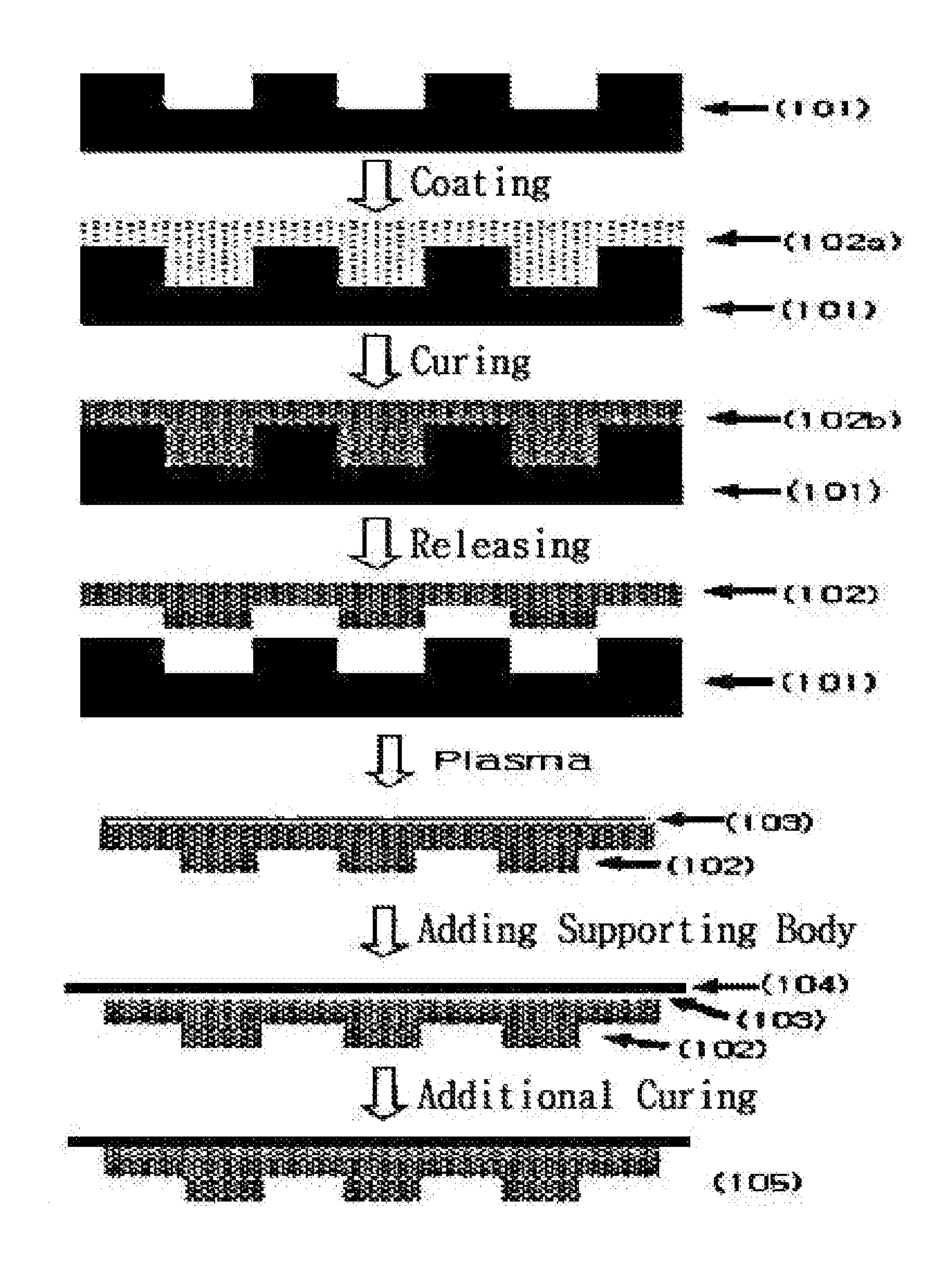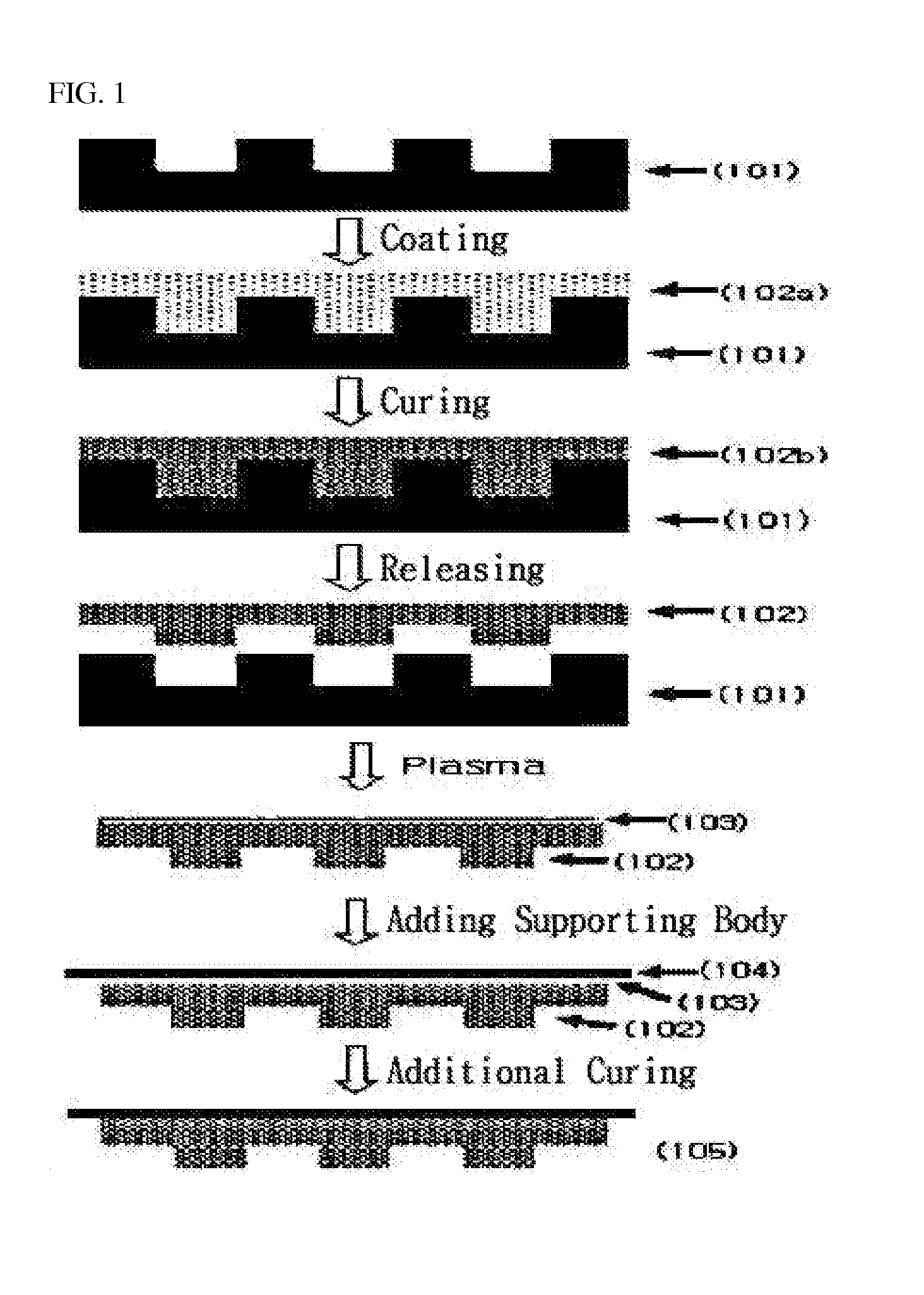Photocurable resin composition containing fluorine and method for producing a resin mold using same
a technology of photocurable resin and composition, which is applied in the field of fluorinecontaining photocurable resin composition and a method of preparing a mold, can solve the problems of increasing manufacturing costs, difficult control, and consuming huge processing time, and achieves high transmittance, and high heat dissipation efficiency.
- Summary
- Abstract
- Description
- Claims
- Application Information
AI Technical Summary
Benefits of technology
Problems solved by technology
Method used
Image
Examples
example 1
[0074](A-1) Preparation of Silicon-Modified Urethane Compound Having Functional Group
[0075]To a flask equipped with a cooling tube and a stirrer were slowly added 500 parts by weight of 2-hydroxylethyl methacrylate; and 100 parts by weight of toluene diisocyanate, which were then slowly heated to 80° C. and stirred to react for 2 hours or so. Then, 50 parts by weight of polydimethylsiloxane and 1 part by weight of triethylamine as a catalyst were added and reacted for additional 3 hours. The disappearance of isocyanate was confirmed by an infrared spectrophotometer thereby to obtain a colorless, transparent silicon-modified urethane compound having a functional group (a-1).
[0076](A-2) Preparation of Reactive Pre-Polymer Having Functional Group
[0077]To a flask with a cooling tube and a stirrer were added 30 parts by weight of the silicon-modified urethane compound having a functional group (a-1) obtained in (A-1); 70 parts by weight of 3-perfluorohexylhydroxylpropylmethacrylate; and ...
example 2
[0084]50 Parts by weight of the silicon-modified urethane compound having a functional group (a-1) obtained in (A-1) of Example 1; 50 parts by weight of 3-perfluorohexylhydroxylpropylmethacrylate; and 3.5 parts by weight of 2,2′-azobis(2,4-dimethylvaleronitrile) were added and then slowly stirred after nitrogen substitution.
[0085]With the exception that the reaction solution was heated to 70° C. and then reacted for 5 hours to prepare a reactive pre-polymer having a functional group, the same method as Example 1 above was carried out.
example 3
[0086]65 Parts by weight of (a-1) the silicon-modified urethane compound having a functional group obtained in (A-1) of Example 1; 35 parts by weight of 3-perfluorohexylhydroxylpropylmethacrylate; and 3.5 parts by weight of 2,2′-azobis(2,4-dimethylvaleronitrile) were added and then slowly stirred after nitrogen substitution.
[0087]With the exception that the reaction solution was heated to 70° C. and then reacted for 5 hours to prepare a reactive pre-polymer having a functional group, the same method as Example 1 was carried out.
PUM
| Property | Measurement | Unit |
|---|---|---|
| wavelengths | aaaaa | aaaaa |
| transmittance | aaaaa | aaaaa |
| transmittance | aaaaa | aaaaa |
Abstract
Description
Claims
Application Information
 Login to View More
Login to View More - R&D
- Intellectual Property
- Life Sciences
- Materials
- Tech Scout
- Unparalleled Data Quality
- Higher Quality Content
- 60% Fewer Hallucinations
Browse by: Latest US Patents, China's latest patents, Technical Efficacy Thesaurus, Application Domain, Technology Topic, Popular Technical Reports.
© 2025 PatSnap. All rights reserved.Legal|Privacy policy|Modern Slavery Act Transparency Statement|Sitemap|About US| Contact US: help@patsnap.com


